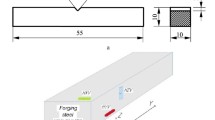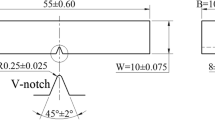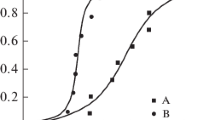Abstract
An attempt to establish a non-empirical relationship between the Charpy V-notch energy CVN and the fracture toughness K Ic is presented. We focus our study on the lower shelf of fracture toughness and on the onset of the ductile-to-brittle transition of a A508 Cl.3 low alloy structural steel. The methodology employed is based on the `local approach'. Brittle cleavage fracture is modelled in terms of the Beremin (1983) model, whereas the ductile crack advance preceding cleavage in the transition region is accounted for with the GTN model (Gurson, 1977; Tvergaard, 1982; Tvergaard and Needleman, 1984. Mechanical testing at different strain rates and temperatures allowed the establishment of the constitutive equations of the material in a rate dependent formulation. Numerous fracture tests on different specimen geometries provided the large data set necessary for statistical evaluation. All specimen types were modelled with finite element analysis. Special consideration was taken in order to handle the dynamic effects in the Charpy impact test in an appropriate way. The fracture toughness could be predicted from Charpy impact test results, on the lower shelf, by applying the `local approach'. In the transition region the parameters of the Beremin model were found to deviate from those established on the lower shelf. Detailed fractographic investigations showed that the nature of `weak spots' inducing cleavage fracture changes with temperature. It is concluded that the Beremin model must be refined in order to be applicable in the ductile-to-brittle transition region.
Similar content being viewed by others
References
Ayres, D. (1976). Dynamic plastic analysis of ductile fracture–the Charpy specimen. International Journal of Fracture 12, 567–78.
Baker, T., Kavishe, F. and Wilson, J. (1986). Effect of non-metallic inclusions on cleavage fracture. Materials Science and Technology 2, 576–582.
Barsom, J. (1975). Development of the AASHTO fracture-toughness requirements for bridge steels. Engineering Fracture Mechanics 7, 605–618.
Barsom, J. and Rolfe, S. (1970). Correlations between KIc and Charpy V-notch test results in the transition temperature range. In: Impact Testing of Metals, ASTM STP 466. Philadelphia, USA, 281–302.
Beremin, F. (1983). A local criterion for cleavage fracture of a nuclear pressure vessel steel. Metallurgical Transactions A 14A, 2277–2287.
Bernauer, G. (1997). Einsatz mikromechanischer Schädigungsmodelle im sprödduktilen Ubergangsbereich. Ph.D. thesis, Universität Karlsruhe, Germany. Also IWM Report W 5/97, Freiburg, Germany.
Bernauer, G., Brocks, W. and Schmitt, W. (1999). Modifications of the Beremin model for cleavage fracture in the transition region of a ferritic steel. Engineering Fracture Mechanics 64, 305–325.
Bodner, S. and Symonds, P. (1960). Plastic deformations in impact and impulsive loading of beams. In: Plasticity. Proceedings of the Second Symposium on Naval Structural Mechanics. (Edited by Lee, E. and Symonds, P.) Rhode Island, USA, pp. 488–500.
Bowen, P. and Knott, J. (1984). Cleavage fracture of A 533 B pressure vessel steel in martensitic condition. Metal Science 18, 225–235.
Bowen, P. and Knott, J. (1985). Some observations on the assessment of short, sharp cracks at the roots of blunt notches, and their effect on brittle fracture. International Journal of Fracture 28, 103–117.
Brooksbank, D. and Andrews, K. (1968). Thermal expansion of some inclusions found in steels and relation to tessellated stresses. Journal of the Iron and Steel Institute 206, 595–599.
Brückner-Foit, A., Ehl, W., Munz, D. and Trolldenier, B. (1990). The size effect of microstructural implications of the weakest link model. Fatigue & Fracture of Engineering Materials & Structures 13, 185–200.
Chen, J., Wang, G. and Wang, H. (1996). A statistical model for cleavage fracture of low alloy steel. Acta Materialia 44(10), 3979–3989.
Chu, C. and Needleman, A. (1980). Void nucleation effects in biaxially stretched sheets. Journal of Engineering Materials and Technology 102, 249–256.
Clough, R. and Wadley, H. (1982). Indentation loading pudies of acoustic emission from temper and hydrogen embrittled A533B steel. Metallurgical Transactions 13A, 1965–1975.
ESIS: 1996a, Proposed standard methods for instrumented pre-cracked Charpy impact testing of steels. European Structural Integrity Society, TC5. Draft 10.
ESIS: 1996b, Proposed standard methods for instrumented pre-cracked Charpy impact testing of steels. Combined KId, JId and CTOD methods. European Structural Integrity Society, TC5. Draft 6.
ESIS: 1997, Draft procedure to measure and calculate local approach criteria using notched tensile specimens. European Structural Integrity Society, TC 1.1. Draft document (v 4.0).
Fearnehough, G. and Hoy, C. (1964). Mechanism of deformation and fracture in the Charpy test as revealed by dynamic recording of impact loads. Journal of the Iron and Steel Institute 912–920.
Fisher, J. and Gurland, J. (1981). Void nucleation in spheroidized carbon steels. Part 1: Experimental. Metal Science 15, 185–192.
Franklin, A. (1969). Comparison between a quantitative microscope and chemical methods for assessment of non-metallic inclusions. Journal of The Iron and Steel Institute, 181–186.
Gibson, G., Capel, M. and Druce, S. (1991). Effect of heat treatment on the fracture toughness transition properties of an A508 class 3 steel. In: Defect Assessment in Components–Fundamentals and applications. (edited by: Blauel, J. and Schwalbe, K.-H.) ESIS/EGF Publication 9, 587–611.
Gurson, A. (1977). Continuum theory of ductile rupture by void nucleation and growth: Part I – Yield criteria and flow rules for porous ductile media. Journal of Engineering Materials and Technology, 2–15.
Heerens, J., Read, D., Cornec, A. and Schwalbe, K.-H. (1991). Interpretation of fracture toughness in the ductile-to-brittle transition region by fractographical observations. In: Defect Assessment in Components – Fundamentals and Applications. (edited by Blauel, J. and Schwalbe K.-H.), ESIS/EGF Publication 9, 659–678.
Hertzberg, R. (1995). Deformation and Fracture Mechanics of Engineering Materials, pp. 390–399. New York (USA): J. Wiley, 4th edition.
HKS: (1997). ABAQUS / Standard, Version 5.7, Theory Manual. Hibbitt, Karlsson & Sorensen, Inc., Pawtucket, RI, U.S.A.
Khalili, A. and Kromp, K. (1991). Statistical properties of Weibull estimators. Journal of Materials Science 26, 6741–6752.
Knott, J. (1967). On stress intensifications in specimens of Charpy geometry prior to general yield. Journal of the Mechanics and Physics of Solids 15, 97–103.
Kwon, D. and Asaro, R. (1990). A study of void nucleation, growth, and coalescence in spheroidized 1518 steel. Metallurgical Transactions A 21A, 117–134.
Mäntylä, M., Rossoll, A., Nedbal, I., Prioul, C. and Marini, B. (1999). Fractographic observations of cleavage fracture initiation in a bainitic A508 steel. Journal of Nuclear Materials 264, 257–262.
Marandet, B. and Sanz, G. (1977). Evaluation of the toughness of thick medium-strength steels by using linearelastic fracture mechanics and correlations between K Ic and Charpy V-notch. In: Flaw Growth and Fracture, ASTM STP 631. Philadelphia, USA, pp. 72–95.
Marur, P. (1996). Numerical simulation of anvil interactions in the impact testing of notched bend specimens. International Journal of Fracture 81, 27–37.
Mathur, K., Needleman, A. and Tvergaard, V. (1993). Dynamic 3D analysis of the Charpy impact test. Modelling and Simulation in Materials Science and Engineering 1, 467–484.
McRobie, D. and Knott, J. (1985). Effects of strain and strain aging on fracture toughness of C-Mn weld metal. Materials Science and Technology 1, 357–365.
Miglin, M., Wade, C. and Van Der Sluys, W. (1990). Analysis of fracture toughness data for modified SA508 Cl2 in the ductile-to-brittle transition region. In: Fracture Mechanics: Twenty-First Symposion, ASTM STP 1074. (Edited by: Gudas, J., Joyce, J. and Hackett, E.), Philadelphia, U.S.A., 238–263.
Mudry, F. (1982). Etude de la rupture ductile et de la rupture par clivage d'aciers faiblement alliés. Ph.D. thesis, Université de Technologie de Compiègne.
Mudry, F. (1987). A local approach to cleavage fracture. Nuclear Engineering and Design 105, 65–76.
Mühlich, U., Siegmund, T. and Brocks, W. (1998). A User-Material Subroutine of the Gurson-Tvergaard-Needleman Model of Porous Metal Plasticity for Rate and Temperature Dependent Hardening. Technical Note GKSS/WMG/98/1, GKSS, Geesthacht, Germany.
Nakamura, T., Shih, C. and Freund, L. (1989). Three-dimensional transient analysis of a dynamically loaded threepoint-bend ductile fracture specimen. In: Nonlinear Fracture Mechanics: Volume I-Time-Dependent Fracture, ASTM STP 995. (Edited by: Saxena, A., Landes, J. and Bassani, J.) Philadelphia, U.S.A., 217–241.
Nedbal, I., Siegl, J. and Kunz, J. (1997). Ductile Initiation of Cleavage in Charpy V-Notch Specimens of Bainitic Steel A508 Cl.3. Research Report V-KMAT-440/97, CVUT-FJFI-KMAT, Prague, Czech Republic.
Norris, Jr., D. (1979). Computer simulation of the Charpy V-notch toughness test. Engineering FractureMechanics 11, 261–274.
Ono, K. and Yamamoto, M. (1981). Anisotropic mechanical and acoustic emission behavior of A533B steels. Materials Science Engineering 47, 247–263.
Perzyna, P. (1963). The constitutive equations for rate sensitive plastic materials. Quarterly of Applied Mathematics 20(4), 321–332.
Renevey, S. (1997). Approches globale et locale de la rupture dans le domaine de transition fragile-ductile d'un acier faiblement allié. Ph.D. thesis, Université Paris XI Orsay, France.
Ritchie, R., Knott, J. and Rice, J. (1973). On the relationship between critical tensile stress and fracture toughness in mild steel. Journal of the Mechanics and Physics of Solids 21, 395–410.
Rosenfield, A., Shetty, D. and Skidmore, A. (1983). Fractographic observations of cleavage initiation in the ductilebrittle transition region of a nuclear reactor-pressure-vessel steel. Metallurgical Transactions 14A, 1934–1937.
Rossoll, A. (1998). Détermination de la ténacité d'un acier faiblement allié à partir de l'essai Charpy instrumenté. Ph.D. thesis, École Centrale de Paris, France. In English.
Rossoll, A., Berdin, C., Forget, P., Prioul, C. and Marini, B. (1999). Mechanical aspects of the Charpy impact test. Nuclear Engineering and Design 188, 217–229.
Ruggieri, C. and Dodds, R., Jr. (1996). A transferability model for brittle fracture including constraint and ductile tearing effects: a probabilistic approach. International Journal of Fracture 79, 309–340.
Sailors, R. and Corten, H. (1972). Relationship between material fracture toughness using fracture mechanics and transition temperature tests. In: Fracture Toughness, Proceedings of the 1971 National Symposion on Fracture Mechanics, Part II, ASTM STP 514. Philadelphia, U.S.A., pp. 164–191.
Server, W. (1978a). General yielding of Charpy V-notch and precracked specimens. Journal of Engineering Material and Technology 100, 183–188.
Server, W. (1978b). Impact three-point bend testing for notched and precracked specimens. Journal of Testing and Evaluation 6, 29–34.
Server, A. (1985). Charpy Impact Testing. In: ASM Handbook, Vol. 8. American Society for Metals pp. 261–268.
Siegmund, T. and Brocks, W. (1997). A User-Material Subroutine Incorporating the Gurson-Tvergaard-Needleman Model of Porous Metal Plasticity into the ABAQUS Finite Element Program. Technical Note GKSS/WMG/97/2, GKSS, Geesthacht, Germany.
Tahar, M. (1998). Applications de l'approche locale de la rupture fragile a l'acier 16MND5:-Corrélation résilience-ténacité.-Probabilité de rupture bimodale (clivage et intergranulaire). Ph.D. thesis, Ecole Nationale Supérieure des Mines de Paris, France.
Tvergaard, V. (1981). Influence of voids on shear band instabilities under plane strain conditions. International Journal of Fracture 17, 381–388.
Tvergaard, V. (1982). On localization in ductile materials containing spherical voids. International Journal of Fracture 18, 237–252.
Tvergaard, V. and Needleman, A. (1984). Analysis of the cup-cone fracture in a round tensile bar. Acta Metallurgica 32 157–169.
Tvergaard, V. and Needleman, A. (1988). An analysis of the temperature and rate dependence of Charpy V-notch energies for a high nitrogen steel. International Journal of Fracture 37, 197–215.
Tweed, J. and Knott, J. (1983). Effect of reheating on microstructure and toughness of C-Mn weld metal. Metal Science 17, 45–54.
Tweed, J. and Knott, J. (1987). Micromechanics of failure in C-Mn weld metals. ActaMetallurgica 35, 1401–1414.
Wallin, K. (1989). A simple theoretical Charpy–V–K Ic correlation for irradiation embrittlement. In: Innovative Approaches to Irridiation Damage and Fracture Analysis, Vol. 170 of PVP. (Edited by: Marriot, D., Mager, T. and Bamford, W.) 93–100.
Wilshaw, T. and Pratt, P. (1966). On the plastic deformation of Charpy specimens prior to general yield. Journal of the Mechanics and Physics of Solids 14, 7–21.
Wullaert, R. (1970). Applications of the instrumented Charpy impact test. In: Impact Testing of Metals, ASTMSTP 466. Philadelphia, U.S.A., 148–164.
Xia, L. and Cheng, L. (1997). Transition from ductile tearing to cleavage fracture: a cell model approach. International Journal of Fracture 87, 289–306.
Xia, L. and Shih, C. (1996). Ductile crack growth–III. Transition to cleavage fracture incorporating statistics. Journal of the Mechanics and Physics of Solids 44, 603–639.
Author information
Authors and Affiliations
Rights and permissions
About this article
Cite this article
Rossoll, A., Berdin, C. & Prioul, C. Determination of the Fracture Toughness of a Low Alloy Steel by the Instrumented Charpy Impact Test. International Journal of Fracture 115, 205–226 (2002). https://doi.org/10.1023/A:1016323522441
Issue Date:
DOI: https://doi.org/10.1023/A:1016323522441




